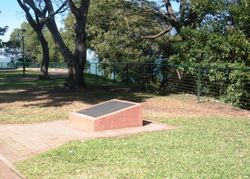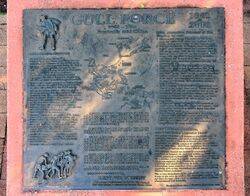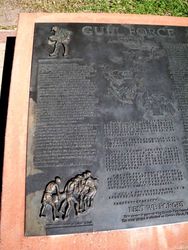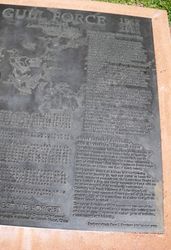
Home » Themes » Conflict » World War Two
Gull Force Prisoners of War MemorialPrint Page 
The sculptured plaque commemorates members of Gull Force and Australian men and women who became prisoners of war of the Japanese during World War Two.
The Gull Force Memorial Project was conceived in the mid 1990`s to provide a tangible, meaningful project that would build on the original reasons for developing the sister city relationship between Darwin and Haikou. The project was concluded in 2003 when two sister commemorative plaques were laid in honour of the men and women, who suffered in captivity at the hands of the Japanese in World War Two on Hainan Island.
The Gull Force, 266 Australian soldiers, fell into the hands of the Japanese while defending Ambon and were relocated to a Prisoner of War (POW) camp to work as slave labour on Hainan Island from 1942 to 1945.
Location
| Address: | Esplanade, Bicentennial Park, Darwin, 0800 |
|---|---|
| State: | NT |
| Area: | AUS |
| GPS Coordinates: | Lat: -12.466667 Long: 130.84 Note: GPS Coordinates are approximate. |
Details
| Monument Type: | Plaque |
|---|---|
| Monument Theme: | Conflict |
| Sub-Theme: | WW2 |
| Actual Event Start Date: | 03-September-1939 |
| Actual Event End Date: | 15-August-1945 |
| Designer: | Ross J. Bastiaan (Melbourne, VIC) |
Dedication
| Actual Monument Dedication Date: | Saturday 5th July, 2003 |
|---|
Gull Force 1942
1942 -1945 2002
Australia and China
[ Chinese Text ]
Lest We Forget
This plaque is presented by Darwin City Council.
The same plaque is situated on Hainan Island China
During the Second World War (1939 to 1945), over 22000 Australian men and women became Prisoners of War (POW) of the Japanese. Most were captured during the 'Fall of Singapore', others in futile attempts by the Allies to defend the many islands to Australia's north. Captivity in all cases resulted in deprivation and brutality beyond previous experience, The defeat of Japan in August 1945 left over one third of Australian prisoners dead.
Some of these deaths occurred on Hainan Island, China, and now its capital Haikou and Darwin are sister cities, linked by this POW tragedy. The 263 Australian soldiers who were part of the 2/21st Infantry Battalion captured defending Ambon in early 1942, were shipped nine months later to Hainan Island as slave labour for the Japanese, The primitive POW camp was at Basuo on the west coast. Australian, Dutch, Indian POW and thousands of indigenous Chinese labourers toiled for up to 7 days a week for over 2½ years, building fortifications and infrastructures for the Japanese.
Atrocities occurred in all Japanese POW camps. Some of the worst occurred on Ambon and Hainan Island. The Chinese on Hainan Island suffered even greater brutality as unrecorded thousands perished. Of approximately 1100 Australians originally captured on Ambon, around 70% were killed by the Japanese as a result of starvation, beating or execution. Despite the cruelty, the Australian prisoners maintained their individuality of spirit but many returned home scarred both physically and emotionally. Australia will never forget their sacrifice.
Main Australian Prisoner of War
Regions in Asia.
1 SINGAPORE-Changi Peninsula was the main camp for Allied POW. Most were detained here before moving on to camps in other countries.
2 BURMA-THAILAND RAILWAY-9500 Australians helped 51000 British, Dutch and American POW and 270000 Asians build the 421 kilometre railway between May'42 and Oct'43. There were 61 work camps with appalling living/working conditions and almost 30% of Australians died.
3 AMBON-1100 Australians captured and only 30% survived the war.
4 HAINAN ISLAND-263 Australians and 245 Dutch POW were shipped here from Ambon Nov'42
5 BORNEO (SANDAKAN)-2500 Allied POW shipped here from Changi Jul'42. In Oct'43 most Australian officers removed to Kuching to join 3000 Allied POW where 1000 subsequently died. At Sandakan in 1944/45, remaining 1800 Australians perished, only 6 escaped.
6 JAVA-Initially 3000 Australians captured here and held in many camps. Most sent to Changi for transit elsewhere and only 385 remained in Java by Jan'45.
7 FORMOSA-Senior Australian officers sent from Changi to Formosa and Korea from Aug'42. Harsh conditions, Formosa POW moved in Oct'43 to Manchuria.
8 JAPAN-In terrible conditions, 1200 Australians worked here in shipyards, mines and factories. 1050 Australians drowned en route to Japan from New Britain POW camp.
9 SUMATRA- Approx 240 Australians (including 32 Australian nursing sisters) held here. Many worked during 1944/45 on the 230 km Sumatra Railway built by 5000 Allied POW (700 died including 40 Australians) and many Indonesians.
2 / 21st Infantry Battalion,
2nd Australian Imperial Force
The 2 / 21st Battalion was composed predominantly of Victorian volunteers and trained there in 1940. The Battalion moved to Darwin in March 1941, and by December, was hastily shipped to Ambon comprising 80% of 'GULL FORCE'. Gull Force reinforced Dutch troops on Ambon, as Ambon was then a Dutch Colony. The Japanese landed on Ambon in overwhelming
numbers on January 31, 1942 and within 24 hours the Dutch command surrendered. The Australians fought on for a further 2 days but vastly outnumbered and with no air or sea support, they eventually surrendered. Captivity and death followed. At Laha airport, 285 Australians were executed. Over a period of 3½ years in captivity, 83% of the Australians on Ambon and 31% on Hainan Island perished. The 2/21st Battalion's POW experience was one of the worst of the war. As well as the impossible military task set them in 1942, they were to endure years of isolation, abandonment and brutality.









